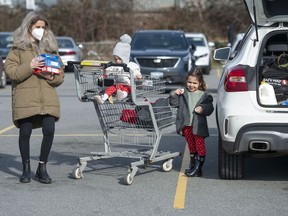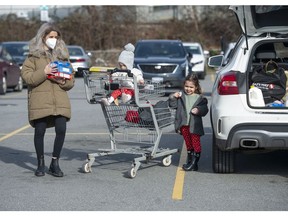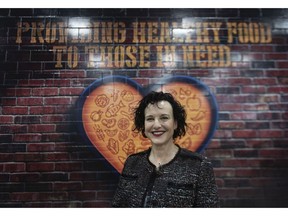Reviews and recommendations are unbiased and products are independently selected. Postmedia may earn an affiliate commission from purchases made through links on this page.
$5 peppers, $40 steaks: Why prices are up and tips to bring bills down

Feeding families is the top financial strain for British Columbians right now. And the war in Ukraine will make this worse, experts say.

Article content
Mandy Alves, like most British Columbians these days, is more cautious while grocery shopping. She buys regular milk instead of organic, cheaper cuts of meat, and basic types of lettuce instead of the more expensive varieties.
Advertisement 2
Article content
Rising food prices are hitting people hard, at a time when the prices of everything are rising, including mortgage interest rates and gas prices.
Experts warn that there is no end in sight, so have some suggestions for how consumers can try to lower their grocery bills.
Some of those ideas — better meal planning and reducing food waste — Alves is considering.
“I think we are going to look at being smarter with planning larger meals that we can have for more than one day,” said Alves, who lives in east Vancouver and is on maternity leave.
She wants to continue to buy berries for her young daughters, 14-month-old Nina and Isla, who is almost four, but the sticker shock has prompted her to buy smaller containers to avoid any going bad before they get eaten.
Advertisement 3
Article content
“I’m definitely more cautious and trying to be a bit smarter,” she said, as she loaded groceries into her car at a Vancouver grocery store.

A Leger poll for Postmedia found nearly three-quarters of B.C. households are spending more on food than last year and those with children reported the biggest rise at almost 80 per cent.
One-third of British Columbians are struggling to pay those higher grocery bills, with the most pain felt by renters, people with incomes below $40,000, and those between 35 and 54.
Leger polled 1,000 adult British Columbians between March 4 and 6, and the survey findings are similar to national polls. An Angus Reid survey in late February found 80 per cent of Canadians are trying to lower their grocery bills, with nearly half switching to cheaper brands, a third cutting back on meat, and one in five buying less fresh fruit and vegetables.
Advertisement 4
Article content
The percentage of British Columbians struggling with food costs, according to Angus Reid, was higher than the Canadian average, which isn’t surprising given the high cost of living in this province.
Some close-to-home events have contributed to empty shelves in grocery stores, such as vaccine protesters shutting down border crossings, last November’s devastating floods in the Fraser Valley, and wildfires and droughts in the summer caused by climate change.
War driving up prices
Russia’s invasion of Ukraine could play the biggest role in rising worldwide food prices, said Matias Margulis, a former Canadian representative to the World Trade Organization and the United Nations’ Food and Agriculture Organization.
Advertisement 5
Article content
“The duration of the invasion of Ukraine, and also how Russia responds and how other countries respond, are going to have huge effects on food prices this year. It’s really important to remember, the best way to track where food prices are going to go, is the price of oil,” said Margulis, an assistant professor in UBC’s faculty of land and food systems and the school of public policy and global affairs.
“Given what we’re seeing right now, it is a concern. It is a major concern.”
Indeed, local gas stations are now charging $2 or more a litre. That’s because gas prices are based on the worldwide cost of crude oil, which jumped in response to the uncertainty caused by the invasion and could continue to climb as many countries ban imports of Russian oil.
Advertisement 6
Article content
This has a trickle-down effect at grocery stores, which get their goods from a global food system that relies on energy for production and transportation, such as petrochemicals used for fertilizer and fuel for tractors and delivery trucks, Margulis said.
The more farmers and food producers have to pay for energy, the more we pay at the checkout.
Global supply chains that were slowed by the pandemic were initially forecast to improve in 2022, but the war could disrupt them again because of decisions to no longer do business with Russian companies, he added.
Margulis was a contributor to an annual food price report released in December, which predicted food prices in British Columbia could jump by seven per cent in 2022.
Advertisement 7
Article content
And given the invasion of Ukraine, it is possible that percentage could now be even higher this year for some commodities, such as meat, he said.
So are there solutions?

Margulis suggested consumers could be better at food storage and precise meal planning, so they reduce waste. One study, he said, found Vancouverites throw out one quarter of the food they buy.
“In the context where food prices are going up, people are really literally throwing out money, quite a lot of money,” he said.
He encouraged consumers to continue to compare prices at different stores, a task made easier by online shopping websites.

‘A really hard time’ for students
Tashia Kootenayoo, a fourth-year English student at UBC Okanagan, said food insecurity is an issue for most post-secondary students because of pressures such as high rent and tuition, but it has become much more severe over the past month or so.
Advertisement 8
Article content
“As a person who is already food insecure, it’s definitely a really hard time right now with rising food prices,” said Kootenayoo, the Indigenous representative for the B.C. Federation of Students.
“I know students who are friends that aren’t coming to campus to go to class because they can’t afford, between gas and food, to come to campus.”
Kootenayoo is paid for her work as president of the UBC Okanagan student union, but one biweekly paycheque goes entirely to rent. With recent price rises, there is not much left of the month’s second cheque for food after she pays for utilities and gas.
She uses the student food bank on campus, and takes advantage of other programs that provide grocery gift cards and other supports to students. When she goes shopping, at times with only $20 in her wallet, she aims to buy healthy food but is shocked these days at how little she can get.
Advertisement 9
Article content
“When I go into the grocery stores, it’s like what vegetable or fruit can I afford that’s going to be low cost and sustain me for more than two meals?” said Kootenayoo, 25, who is from the Alexis Nakota Sioux Nation in Alberta.
Shauna-Lee Hildred, who works for the UBC Okanagan student union, opened the campus food bank in 2019. She said UBC Okanagan academic research conducted then found more than 40 per cent of campus students were food insecure, a much higher figure than in the public.
The escalating prices are a real double-whammy to students right now, as shown by February and March being the busiest months for the campus food bank. In part, that’s because savings from summer jobs are starting to run out and because February student-loan cheques contain the lowest payment amounts, she said.
Advertisement 10
Article content
“As well, they’re just trying to get through their final exams. So we typically notice an increase in usage in the food bank this time of year, regardless of rising food costs,” Hildred said.
International students and those from marginalized communities are among those hit hardest by rising food prices, statistics that are similar to the general population.
“Students of colour, Indigenous students, students with disabilities, students with families — they’re all disproportionately impacted by these rising costs and by food insecurity,” Hildred said.
The UBC Okanagan food bank is funded by the students union and the proceeds of on-campus fundraisers. It is a “judgment-free zone,” Hildred said, emphasizing that people from all walks of life should not feel stigma or shame about using a food bank because it is there to help.
Advertisement 11
Article content

‘Pretty steady incline’ at food bank
Demand is also on the rise at the Greater Vancouver Food Bank, which this year has registered 500 new clients a month, compared to a monthly average of 400 last year. Of the more than 10,000 people it supports each month, one quarter are children under the age of 18 and nearly one in five are seniors.
“Since the summer, we’ve seen a pretty steady incline in the number of clients,” said the chief operating officer, Cynthia Boulter.
A new distribution warehouse opened in July in Vancouver, where community agencies pick up supplies they distribute on behalf of the food bank. “We are breaking records there virtually every month,” Boulter said.
And with the rising cost of food, she believes demand will continue to climb at the food bank.
Advertisement 12
Article content
“We’ve certainly increased our purchasing to try and get ahead on the non-perishables and find whatever deals we can. We are looking where we can to expand refrigeration, because we’re kind of full at the moment. So yes, we do anticipate that we will continue to see more clients,” she said.
Many of the new food bank clients are single people who struggle to make ends meet on their own, and there is also an increase of clients who are international students and newcomers to Canada.
Ninety per cent of food bank clients have some source of income, such as a job, pension or disability payments.
“We have a lot of people who don’t have a lot of light at the end of the tunnel, with that fixed income. Close to 30 per cent talk about low wages, it’s just not enough.
Advertisement 13
Article content
“We’re in the most expensive province to live. Housing is insane. Gas is insane — we always see if there’s a big uptick in gas prices, we will generally see an uptick in client visits. And the cost of food, of course, we all feel it,” Boulter added. “All of our taxes and utilities have gone up. Inflation is at a 30-year high. And people’s wages aren’t increasing to that level.”
She is proud that half the food a client now gets from the food bank is fresh, including fruit and vegetables, meat and fish, eggs and dairy products, and ready-to-eat meals, thanks to donations from grocery stores and other supporters.
“It’s pretty amazing, especially at a time like this when it is so expensive,” Boulter said, adding the food bank has created packages with specialized fresh food for babies, toddlers, preschoolers, school-age children and seniors.
Advertisement 14
Article content
In the longer term, organizations like Food Bank Canada push for solutions to food insecurity, such as a guaranteed basic income that would allow people to afford to buy groceries.
Margulis, the UBC professor, argued changes need to be made because food inflation is a serious problem for some segments of the population, such as those with a lower-income, renters and students.
“It’s a wider societal issue, thinking about how do we secure affordable food for all in a time when we’re definitely seeing inflation, and decreasing purchasing power and standard of living?”
Given the recent shocks to grocery bills, he believes the federal government needs to re-evaluate Canada’s supply management system, which limits the supply of dairy, poultry and eggs to the amount that consumers are expected to consume, in order to try to keep prices stable.
Advertisement 15
Article content
The national Angus Reid survey found more than two-thirds of Canadians supported supply management, but a quarter thought a temporary pause of supply-managed price increases would be helpful while costs escalate.
While Canada produces a large amount of wheat for domestic consumption, Ukraine is also one of the world’s biggest wheat exporters and the UN World Food Program warned this week about a potential global food crisis if the war continues and warned the price of grain could continue to rise.
Vegetables, dairy, bakery prices to rise
The national food report predicted the biggest cost increases in 2022 would be for dairy, up by eight per cent, bakery items, up by seven per cent, and vegetables, also up seven per cent.
Advertisement 16
Article content
Most Canadians need to eat more vegetables, so it is a problem that they may reduce their intake if prices remain high, Prof. Kelleen Wiseman, the lead UBC researcher on the report, said when it was released in December.
But some vegetables are less expensive than others and frozen vegetables “can provide high nutritional value at a lower price,” added Wiseman, the academic director of UBC’s masters program in food and resource economics.
Canada’s Food Price Report 2022 also predicted an average Canadian family of four would pay nearly $15,000 in 2022 for groceries, a rise of $966 over 2021.
“We can expect food insecurity to become a growing issue in 2022 as the inflation rate and food prices continue to rise. There will likely be more demand for and reliance on food programs or food banks if incomes do not rise to meet food expenditures and other basic needs,” says the report.
The main author is Sylvain Charlebois, director of the agri-food analytics lab at Dalhousie University.
“In 2022, we can anticipate the ongoing effect of the continuing climate crisis and adverse weather effects on food prices,” added the report, which was written before Russia’s invasion of Ukraine.
Advertisement 17
Article content
Charlebois issued a report this week that found so-called shelflation is rising in Canada — when supply chain disruptions cause food to go bad sooner than buyers expected.
His research found Canadians may have thrown away nearly $550 million worth of food in the last six months due to shelflation. That’s difficult for low-income families who cannot afford to replace lettuce or chicken that spoil earlier than anticipated.
Struggling to pay for food was the top financial concern for British Columbians, just ahead of worrying that income wouldn’t cover the bills and stress about the household’s financial position, according to the Leger poll.
Nearly 30 per cent of those surveyed in the poll — which has a margin of error of plus or minus 3.1 per cent, 19 times out of 20 — said they had changed how they spend their money. Half said they eat out less, 40 per cent spend less on entertainment, and a quarter have cut back on public transportation, alcohol, cigarettes and cannabis.
Kootenayoo has already cut spending as much as she can. With more than a month left in the post-secondary school year, she will be juggling her worries about food insecurity and final exams.
“I’m trying to figure out what resources are available that can help remediate the stresses that I have in regards to food, and other costs of living as a student, so that I can focus on what’s left of my studies,” she said.
Source: vancouversun.com


